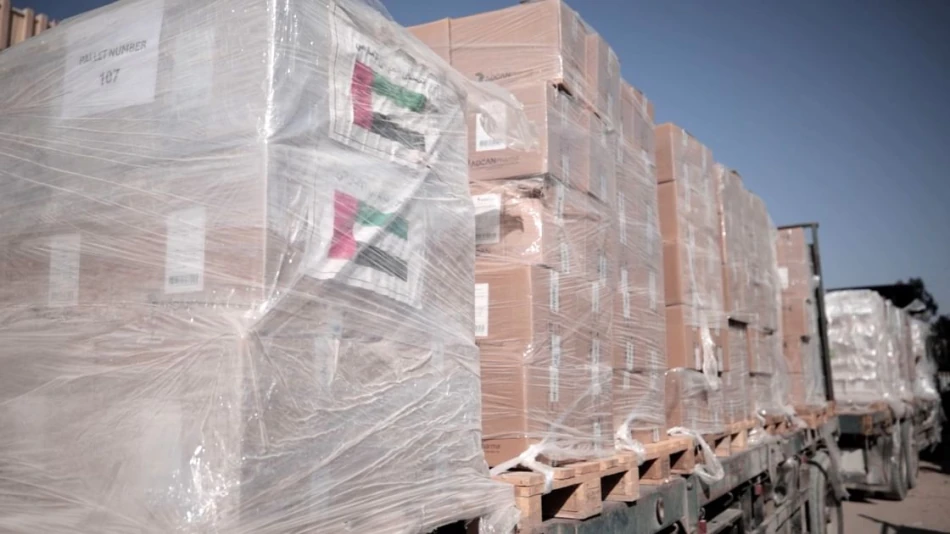
Gallant Knight 3" Launches "Life and Hope 2" Convoy to Support Gaza Hospitals and Bolster Healthcare Services
UAE Delivers Critical Medical Aid to Gaza as Healthcare System Faces Collapse
The United Arab Emirates has dispatched its second "Life and Hope" medical convoy under Operation Chivalrous Knight 3, delivering urgently needed medicines, medical equipment, and supplies to Gaza's overwhelmed hospitals. The initiative comes as Gaza's healthcare infrastructure teeters on the brink of total collapse, with medical facilities reporting complete depletion of essential supplies amid ongoing conflict.
Emergency Response to Healthcare Crisis
The convoy's arrival was announced during a press conference at Nasser Hospital in Khan Younis, highlighting the acute shortage of medical supplies that has pushed Gaza's hospital system to breaking point. Dr. Abdulrahman Hamad Al-Aryani, director of the UAE field hospital, emphasized that the medical assistance represents a continuous effort to support Gaza's healthcare sector during what he described as exceptionally difficult circumstances.
The timing of this delivery is particularly significant. Gaza's hospitals have been operating on fumes for months, with medical staff forced to make impossible decisions about patient care due to supply shortages. This UAE intervention provides a crucial lifeline that could mean the difference between functional healthcare and complete system failure.
Strategic Humanitarian Diplomacy
The UAE's approach through Operation Chivalrous Knight 3 represents more than emergency aid—it's a calculated exercise in humanitarian diplomacy. Sharif Al-Nairab, media official for the operation, stressed that supporting Gaza's healthcare sector remains a top priority for the Emirates, with medical convoys set to continue without interruption.
This sustained commitment distinguishes the UAE's response from one-off aid deliveries. By establishing a systematic, ongoing support mechanism, the Emirates is positioning itself as a reliable partner in regional crisis management, potentially strengthening its diplomatic influence across the Middle East.
Regional Context and Comparison
The UAE's medical diplomacy in Gaza follows a broader pattern of the country using humanitarian aid as a foreign policy tool. Similar to its disaster response efforts in Lebanon, Syria, and Yemen over the past decade, the Emirates leverages its logistical capabilities and financial resources to project soft power while addressing genuine humanitarian needs.
Unlike traditional donor approaches that rely heavily on international organizations, the UAE's direct operational involvement—including establishing and maintaining field hospitals—allows for more immediate impact and greater visibility of its contributions.
Healthcare System on Life Support
Dr. Mohammed Zaqout, Director General of Hospitals at the Ministry of Health, acknowledged that the UAE support arrives at a critical juncture when Gaza's healthcare system faces complete medication and medical supply depletion. His comments underscore the severity of the crisis: without external intervention, basic medical services would cease to function.
The systematic nature of Gaza's healthcare collapse—months in the making due to conflict and blockade conditions—means that sporadic aid deliveries, while helpful, cannot address the underlying structural problems. However, the UAE's commitment to sustained support through multiple convoys suggests recognition of this reality.
Implications for Regional Stability
Beyond immediate humanitarian impact, the UAE's medical intervention carries broader implications for regional stability. Healthcare collapse in conflict zones historically leads to increased civilian casualties, refugee flows, and long-term reconstruction challenges. By helping maintain basic medical services, the Emirates may be contributing to preventing an even larger humanitarian catastrophe.
The operation also demonstrates how middle powers like the UAE can fill critical gaps when larger international mechanisms prove inadequate or too slow to respond effectively. This model of direct, sustained humanitarian intervention could influence how future regional crises are addressed, potentially reducing dependence on traditional international aid architectures.
Most Viewed News

 Sara Khaled
Sara Khaled






